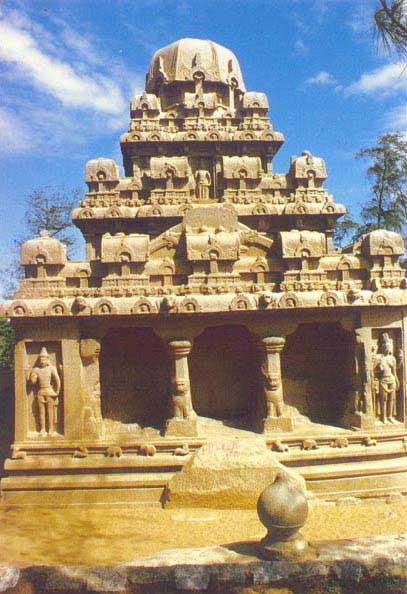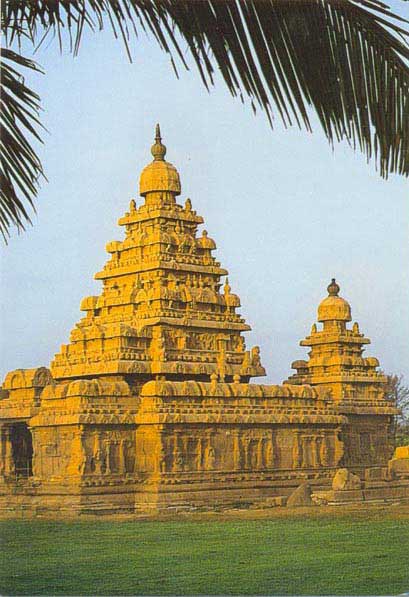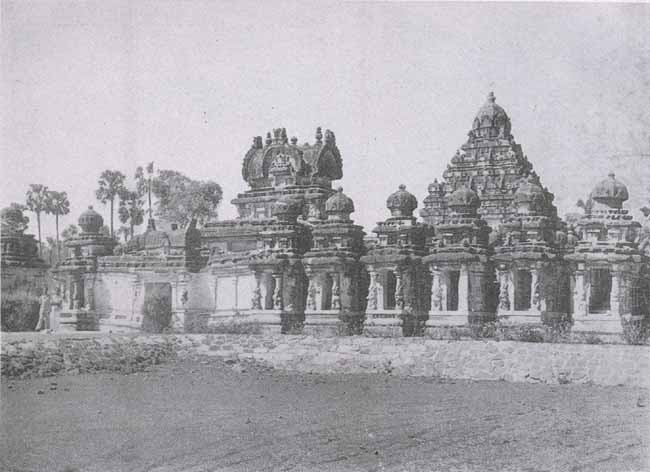PALLAVA or DRAVIDIAN ARCHITECTURE
The South Indian temples have made a rich contribution to temple architecture in India. The development of the Bhakti Cult in the form of Saivism and Vaishnavism resulted in the worship of idols and construction of temples. Starting with the rule of the Pallavas in the 7th Century A.D. temple architecture gradually continued to develop during the Chola Period (900 – 1150 A.D.), the Chalukya and Hoysala Period (10th to 12th Century A.D.), the Pandya Period (1100 A.D. to 1350 A.D.), the Vijayanagar Period (1350 A.D. to 1565 A.D.) culminating in the final phase of the Dravidian style during the rule of the Nayak rulers of Madurai.
The South Indian temples are institutions by themselves and are centres of community life – Public and Religious. Here, people gathered to worship, discuss social, political and religious matters. They were centres for music, dance and drama. They had schools and colleges attached where free secular and religious instruction were given as per the Agama Shastras, they maintained people of various crafts and occupations as temple staff to serve the needs of the community. They have thus contributed to the all-round development of the individual in Society.
The Dravidian or Pallava style was introduced during the Pallava Rule. The earlier form of this style is seen in the rock cut temples or Rathas of Mahabalipuram. Known as the Seven Rathas and named after Ganesh, Draupadi and the Five Pandava brothers, these temples are cut out of solid rock, have mandaps and pillared halls. They are monolithic shrines.
Mahabalipuram or Mamallapuram, 59 Kms. south of Madras, was founded by Narasimhavarman I Pallava who ruled over the area in the 7th Century A.D. There are a number of cave temples with beautiful mandaps and figures of lions – the symbols of the Pallava Simha Vishnu prominently displayed.
The Seven Rathas were excavated during the reign of Narasimhavarman 1. The Dharmaraja Ratha is the largest of the group and is 12.8 mtrs. long. Its height is 12.3 mtrs feet. Built on a square base, it has a 3-tier pyramidal superstructure with a stupa adorn it on top. The Draupadi Ratha is the smallest and most elegant. Dedicated to Saivism, these rathas have around them images of lions, elephants and bulls carved on rocks as symbols of Durga, Indra and Shiva respectively.
The temples, mostly pyramidal structures have either a square or rectangular base. The superstructure of the Bhima Ratha is different and is semicircular in shape like the vaulted roof of a wagon. The mandaps and Rathas are adorned with beautiful sculptured figures and panels. The most beautiful and well-known of these is that showing the ‘penance of Arjuna’ or as described by some artists the ‘Descent of Ganga’.

Dharmaraja Ratha, Mahabalipuram
(Picture courtesy Archaeological Survey of India)
SHORE TEMPLE, MAHABALIPURAM
The Shore Temple at Mahabalipuram, built during the reign of Narasimha 11 is on the seashore. Facing east, the temple has a small gopuram with a pradakshina path between the temple and the outer wall. The main shrine contains a broken fluted Shiva linga. Opposite the gopuram is the dwaja sthamba. The outer walls of the temple are covered with carved panels separated y lions. Many of these have been destroyed by the dashing waves of the sea. Behind this shrine is another cell with a figure of Vishnu reclining on the serpent sesha. Next to this and facing west is another shrine dedicated to Shiva. Opposite the Temple is the Balipitha or altar. The courtyard is surrounded by rows of Nandis. Rocks carved with the eight-armed Durga on a lion can also be seen near the temple.

Shore Temple, Mahabalipuram
(Picture courtesy Archaeological Survey of India)
The second phase of Pallava art begins towards the end of the 7th century AD and continues in the 8th century AD in the form of structural monuments. Splendid temples were constructed during this period. The characteristic feature of these temples is the high shikharas ascending tier upon tier, diminishing in size. The most beautiful examples of this style are the Kailashnath Temple dedicated to Shiva and the Vaikuntha Perumal Temple to Vishnu both located at Kanchipuram. These are a development on the style of previous temples and contain a flat roofed mandap surrounded by numerous cells. Rock and brick were used in the construction.
The Kailashnath Temple of Shiva was built by Rajasimha Pallava and his son Mahendravarman. Built of coarse sandstone, it has a four-storeyed square vimana. The sikhara is octagonal. Three of the four storeys of the vimana are decorated with miniature vimanas and the fourth has four nandis on the four corners. The bases of the mandapa pillars have lions sculptured on them. The temple has a courtyard on all four sidesin which there is a row of fifty four small shrines. A temple wall encloses the temple complex. The inner and outer walls of these shrines are adorned with fresco paintings while the walls of the main temple are profusely decorated with sculptures.

Kailashnath Temple, Kanchipuram
(Picture courtesy Archaeological Survey of India)
The Vaikuntha Perumal Temple was constructed by Nandivarnam in the 7th century AD and is dedicated to Lord Vishnu. It is built on a plan similar to the Kailashnath Temple. Built of sandstone and granite, it is a large square temple with a four storeyed vimana. The temple contains three garbha-grihas or sanctum cells, with an idol of Vishnu sitting, standing and reclining. The walls of the storeys and the mandapa have beautiful sculptures on them. A pillared cloister surrounds the shrine. The temple is important for the series of inscriptions describing the wars between the Pallavas and the Chalukyas and the sculptured panels depicting the history of the Pallava rulers.
Pallava art was also carried across the seas to South-East Asia. An example of Pallava art is seen in the Temple of Angkor Vat in Cambodia built by King Suryavarman. Dedicated to Shiva, it is the largest temple in the world. The temple is built on a vast terrace and has many spires and towers. It has three terraces or galleries one above the other getting smaller in size as they go up. They are connected by stairs. A pyramidal temple, the central tower is the highest of the twelve surrounding towers. The temple walls and galleries are adorned with fine sculptures of birds, flowers, dancers and scenes from the Ramayana and Mahabharata and the puranas. The temple is enclosed by a boundary wall and a moat. Built by Indian builders it is a magnificient structure.
No comments:
Post a Comment